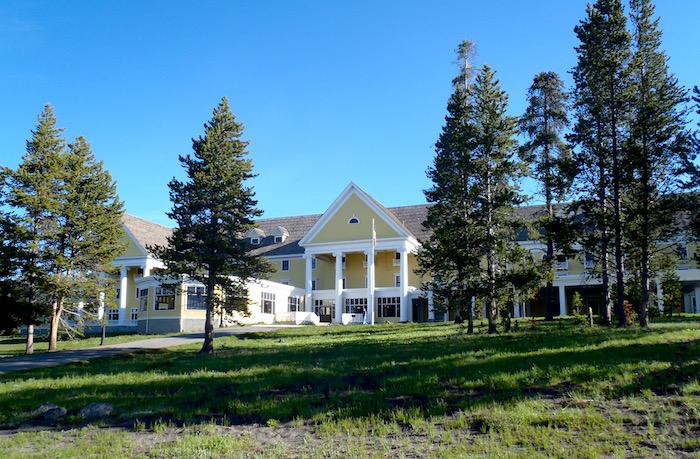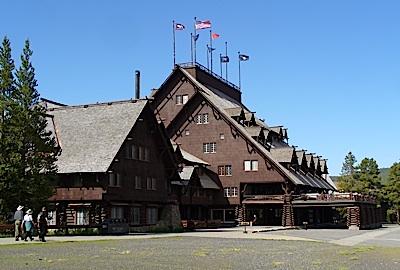
A room at Lake Hotel this summer could cost you $400 a night/Kurt Repanshek file
Lodging rates in Yellowstone National Park jumped this year under an unannounced "pilot program" that allows Xanterra Parks & Resorts to charge what the market will bear for slightly more than half the rooms available for visitors.
The five-year program, approved last year and instituted this year, divides rooms in places such as the Old Faithful Inn, Lake Hotel, and Mammoth Hotel into "core" and "non-core" categories. Rates for core rooms (1,076 in the park) are based on comparable motel rooms found in gateway communities, while non-core rooms (1,219) are priced at what Xanterra believes visitors will pay.
"In the case of Yellowstone’s pilot program, the split is approximately 50-50, and the non-core rooms are those that are considered most unique, such as historic properties," Yellowstone spokeswoman Morgan Warthin said in an email. "This method is intended to reduce challenges in finding comparables for these unique room types."
It can be challenging to arrive at comparable room rates outside the park. Most of Yellowstone's lodges operate for a short five-month season, and so there are costly logistical issues that lodges and motels outside the park that operate year-round are not confronted with, such as retaining staff. Severe winters along with cold spring and fall months can have a great impact on utility costs in the historic lodges, and Park Service requirements can add to operational costs.
On the other hand, Yellowstone's very setting can't be matched, and so lodgings are booked and often sold-out months in advance.
All that considered, the rate jumps encountered this year can be surprising. Five years ago a standard room with two double beds in Old Faithful Inn in mid-August cost $221 ($250.61 with taxes and utility fees). This summer the rate is above $300 (Xanterra's website does not show rates for sold-out dates, though a similiar room for this coming October 6 is listed for $306). If the room's rate tracked inflation, it would be offered for $239 this year.
At Lake Hotel, perhaps the queen lodging destination in the park, rates approach $400 a night if you want a lakeview room with a queen bed.
Xanterra officials point out that room rates in the gateway town of West Yellowstone in mid-summer are similar to their non-core room rates, citing nightly rates at the Best Western Weston Inn ($350), Hibernation Station ($309), Days Inn ($278), Holiday Inn ($359), and the Stagecoach Inn ($299).
"The fact is that many hotels outside the gate are charging higher rates than the market demand-based rooms inside the park, and only three out of nine properties are market-based," Betsy O'Rourke, Xanterra's chief marketing officer, said in an email. "Six remain on traditional National Park Service pricing models."

Rates also are rising at the Old Faithful Inn/David and Kay Scott
However, rates in West Yellowstone fall quickly after summer passes. While Xanterra's rates currently remain high into October ($260-$394 at Lake Hotel, $306 at Old Faithful Inn, $285 at Grant Village through the end of September), rates in West Yellowstone lodgings already are showing steep drops, with the Holiday Inn charging $187 per night for a room with two beds and the Best Western Weston $151 per night for a room with two queens. The Stagecoach Inn offers rooms at $161 for early October, according to its website.
Since the pilot program can reflect waning demand, rates in park lodgings can decline. That already can be seen at Grant Village, where a room at the end of September is down from $322/night to $285.
"We will offer lower rates and/or be closed depending on the location," said Ms. O'Rourke.
If price is not an issue for your Yellowstone stay, market-based rooms (and so, higher rates) are at the Old Faithful Inn, Canyon Lodge, and Lake Hotel. Rooms based on out-of-park comparables can be found at Roosevelt Lodge, Old Faithful Lodge, Old Faithful Snow Lodge, Mammoth Hotel, Lake Lodge, and Grant Village.
"There are many different lodging options at a wide range of prices throughout the park and people choose what’s best for them in location and price," said the Xanterra marketing officer.
While there have been reports that the higher rates were being permitted to offset cost overruns Xanterra incurred with building new lodging at Canyon, both the concessionaire and park officials said that was not true.
Allowing concessionaires to charge more for the services they provide in parks long has been called for by the National Park Hospitality Association, which lobbies on behalf of concessionaires. The organization sees it as one way to provide more revenues, via concession fees, to the Park Service to help reduce the agency's maintenance backlog.
“The visitor services we provide in national parks are often inhibited by NPS policies which limit visitor experiences and reduce our payments, called franchise fees, to the agency," Derrick Crandall, counselor to the National Park Hospitality Association, told a congressional subcommittee three years ago. “We are confident that increases in visitor services, including lengthening operating hours at units like Alcatraz and Statue of Liberty, adding appropriate services and allowing dynamic pricing of services, could increase franchise fees to the NPS by 50 percent within three years."
What the public will bear remains to be seen. An attempt by Interior Secretary Ryan Zinke to implement surge pricing for entrance fees to 17 national parks to generate more funds to combat the maintenance backlog across the country was dropped after immense public and political opposition.
Going forward, Yellowstone officials plan to monitor the public response to the what-the-market-will-bear pricing for lodging.
"The park always considers the impact prices have on visitors and ways to improve visitor experiences and efficiency of operations in Yellowstone," said Ms. Warthin. "That's why this pilot allows certain lodging rooms to be designated as core and others as non-core rooms. This is also a pilot and will be evaluated throughout its planned five-year term. We are collecting feedback on the rate method pilot and will be evaluating the pilot based on that feedback."
Traveler footnote: Room rates cited in this article were based on information available on June 29, 2018, and could change.



Comments
I prefer campsites as well - especially those in the backcountry. But a pampered night in a historical hotel every once in a while is a nice luxury.
Yes what the market will bear is my standard. Any other number is purely arbitrary. That young family may consider it more than they want to pay, but that doesn't make it overpriced.
In a nutshell, here is the history of "lodging" in the national parks, It was never cheap--and never "middle class." Years ago, on my inflation calculator, Christine and I were paying upwards of $400 a night for a room at the Ahwahnee, Old Faithful Inn, and El Tovar. What kept those prices from exceeding $500 per night? We only stayed during periods of recession, when yes, even those prices tended to stabilize. We wouldn't dream of staying in any of those places now. The bargains--if there are any--are in the less popular parks.
Okay. All of us want "equity" again. The poorest among us should be able to afford it. After all, these are national parks. But seriously, when has that ever mattered? Only Bernie Sanders thinks life should be "free."
Make the lodges "cheaper" and you'll never get inside a one of them. That's the truth of anything rare--and in demand. They're not cheap because they're rare. Even the wealthy have to stand in line to get in.
Where I fault the Park Service is not to have charged the concessionaires a true fair market price for these contracts. And even that would be passed on to the public, so again, who is kidding whom?
The national parks are an expensive enterprise. Always have been and always will be. Now, try buying a ticket to a baseball game one of these days. Talk about going broke.
Well, of course it does you silly. By simple definition alone, it is overpriced for them and and that is a fair opinion for them to have. It is not overpriced for you profit-motivated folks, because you and your ilk are gathering all the spare dollars that we don't know how to manage.
Higher than one wants to pay is different than overpriced. Starbucks coffee cost more than I want to pay for coffee. Does that make it overpriced? Millions of people don't seem to think so. If it were indeed "over priced" there would be no demand. If $400 for a hotel room is overpriced, there will be no demand.
Well, of course it does you silly. By simple definition alone, it is overpriced for them and that is a fair opinion for them to have. It is not overpriced for you profit-motivated folks, because you and your ilk are gathering all the spare dollars that we don't know how to manage.
That's a massive oversimplification. There's typically been a variable range of lodging. You mention the Ahwahnee and El Tovar, which do have their place. The Ahwahnee was part of a series of lodging that was built in order to provide support needed for the political viability of our national parks. That doesn't mean that there weren't a wide range of options, including ones that were purposely made to be relatively inexpensive and accessible to those who don't want to pay as much. When I took my grand national park trip in 2006, I stayed at several cabins and I still have the reservations saved. Yellowstone was $70/night at Old Faithful Lodge and $74/night at Canyon Lodge (which is now gone). I stayed at one of the Maswik Lodge quad-cabins (also no longer there) at Grand Canyon for $80/night. I made all these reservations around February for dates in June. In fact they cost way less than the more expensive lodging that was more or less fully booked for about the same timeframe. I like that the federal government generally regulates the prices, because it is government property, and because it was generally considered a public good to allow the public to have access to government property at a reasonable price.
y_p_w. I believe we were talking about the type of lodges pictured in the article. Of course you can stay at cheaper lodges and cabins, which also sell out most of the time. Meanwhile, just for the record, I wrote the book on greedy concessionaires. It's called Yosemite: The Embattled Wilderness, nor have I changed my mind for the second edition, forthcoming in 2020.
What I have revised is my former certainty that people will respond to what is "right." If I write the book--and show them "The Way"--they will do the right thing, as it were. They won't--nor will the Park Service--now a political animal if ever there was one. Nor has it mattered who occupied the White House. The business community--including that surrounding the parks--generally gets its way.
Prices will go up until there are vacant rooms. Then they will stabilize and maybe drop. Speaking of which, my $85,000 starter home here in Seattle (1984) just hit $1.2 million, my neighbors tell me. That's what the starter home across the street just sold for--and that in 24 hours after dozens of bids.
Finally, I'm a millionaire! Now perhaps I can afford the Ahwahnee! It's just that, well, there's this little thing called property taxes. OMG! I'm broke again!